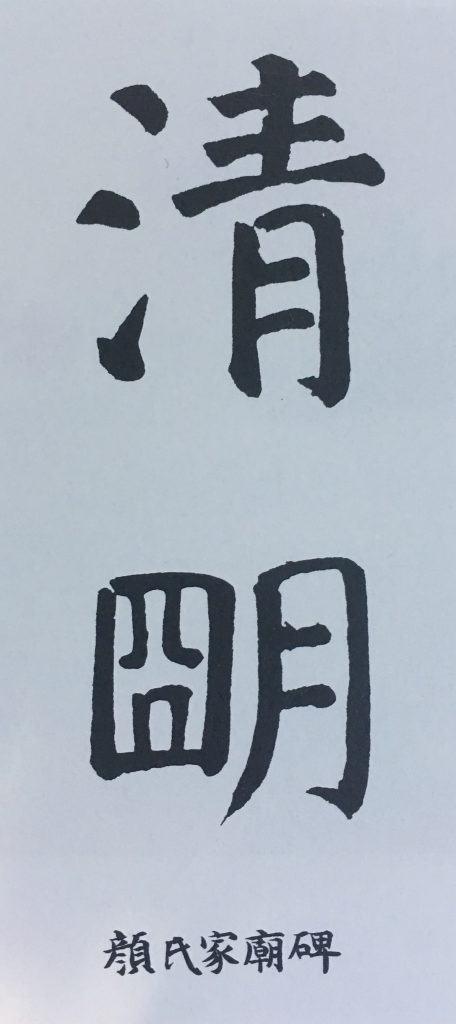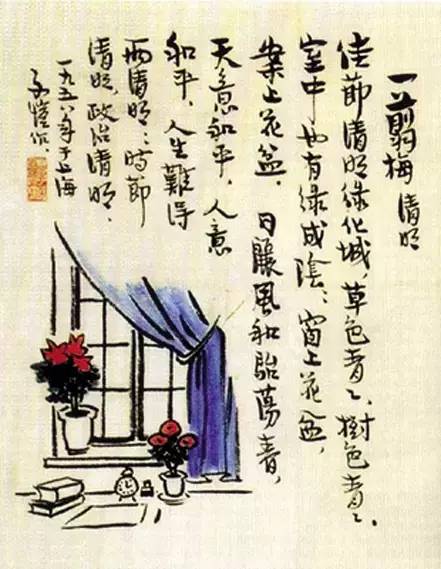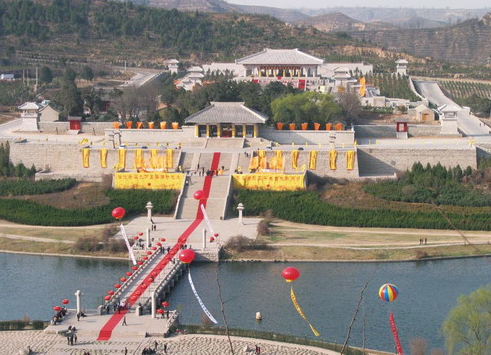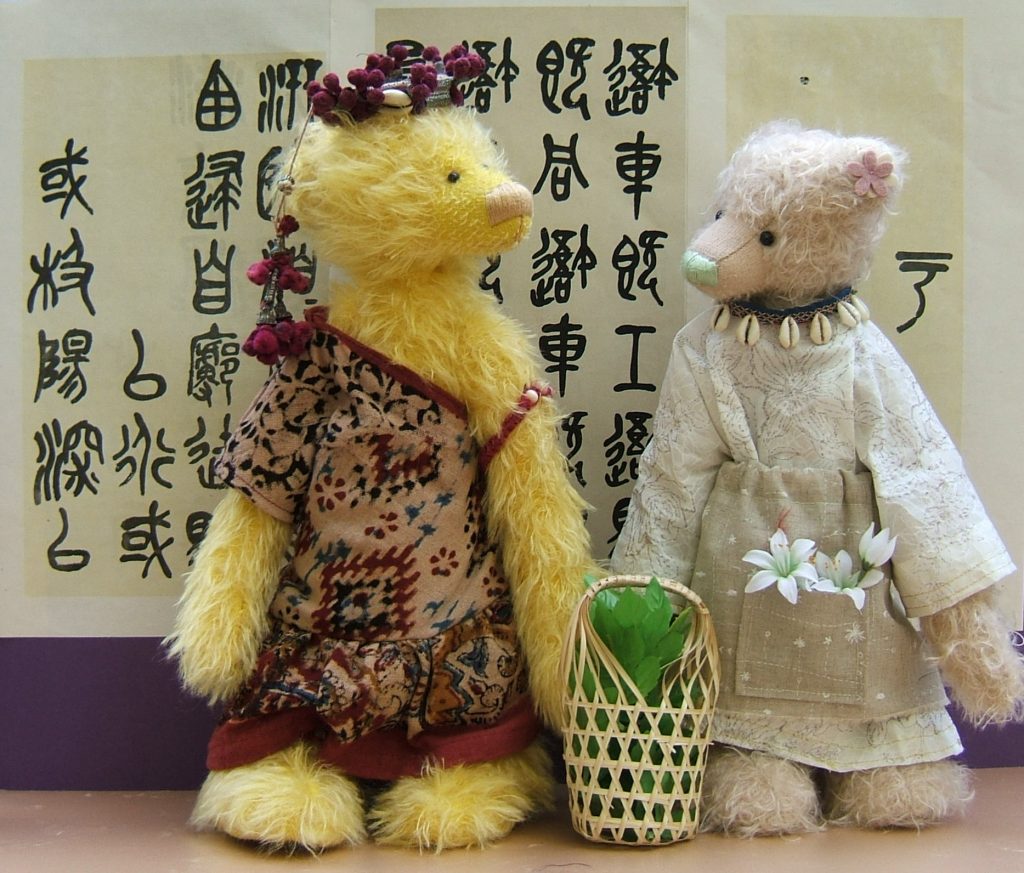The Fourth of April 2017 marks the day for ‘sweeping the tombs’ 掃墓, a festival on which respect is paid to loved ones and forebears. Known since ancient times as Qingming 清明, ‘Clear and Bright’, it is the Eighth Day of the Third Month (depending on the year, this can be the 4th, 5th or 6th of April according to the Gregorian Calendar). Qingming comes less than a week after the Third Day of the Third Month 上已節, a time of ritual purification and seasonal celebration discussed in Spring Lustration. Visiting ancestral graves was an occasion both to give thanks and to take delight in the season, for that reason it is also known as the time of Spring Excursions 春遊踏青 (also 踏春).
Here we mark the first Qingming Festival since the launch of China Heritage by remembering some of our own Ancestors 先哲庇蔭. They are scholars and friends whose work, teaching and guidance nurtured the minds and the hearts of their students. Their influence, or protecting shade 庇蔭, now contributes to the evolution of China Heritage.
On this occasion, we remember with links to memoirs, eulogies and essays:
- David Hawkes: an obituary by John Minford
- Liu Ts’un-yan 柳存仁: eulogies by Pierre Ryckmans and John Minford
- Alistair Morrison: in memoriam by Claire Roberts
- Pierre Ryckmans (Simon Leys): an essay by Geremie R. Barmé
- Yang Hsien-yi 楊憲益, Gladys Yang and The Layabouts Lodge 二流堂
- Yang Tsung-han 楊宗翰: An Imperfect Understanding by Liu Ts’un-yan
- Anthony C. Yu 余國蕃: in memoriam by John Minford
On a personal note, apart from my immediate teachers and members of The Layabouts Lodge 二流堂, I also remember here friends in Hong Kong and Beijing who guided my fifteen-year career as a Chinese writer. They are: Yeung Lai-kwan 楊莉君, Luo Fu 羅浮, Pan Jijiong 潘際迥 and Fan Yong 范用. (They feature, along with others who are still with us, like Ng Sing-fun 吳承歡 and Lee Yee 李怡, in the introduction to An Artistic Exile, 2002.) I am also always grateful to the activist historian Marilyn B. Young who passed away this year. It was during a three-month visiting professorship in history at New York University in 1996 on Marilyn’s invitation that I met the photographer Lois Conner, with whom I have worked ever since.
On this 2017 Qingming we recall too the life and work of Burton Watson, a translator of Chinese and Japanese prose and poetry whose vast achievement has contributed over many decades to our understanding and to our reading pleasure. This great translator passed away in Japan on 1 April 2017.
— Geremie R. Barmé, Editor, China Heritage
Eighth Day of the Third Month of the
Dingyou Year of the Rooster 2017
丁酉雞年三月初八清明節
4 April 2017
***
This is the latest in a series of New Sinology Jottings 後漢學劄記. For more in this series, see here.
The Ancestor of the Myriad Things
似萬物之宗
The Tao is Empty.
But in Practice
Never needs to be filled.
The Tao is Fathomless,
Like the Ancestor of the Myriad Things.
Smooth the Edges,
Loosen the Tangles,
Soften the Light,
Merge with the Dust.
The Tao is crystalline and still,
It seems to have been here for ever.
I know not whose Child it is,
It seems to have been
Before the Emperors of Old.
— ‘Empty’, Chapter Four of
The Tao and the Power,
from a new translation of the classic
Daodejing 道德經 by John Minford.
[The calligraphy is in the hand of Zhao Mengfu 趙孟頫 of the Yuan dynasty]


In The Dragon Raises its Head, published on the Second Day of the Second Month of this Year of the Rooster, we quoted the singer-songwriter Hou Dejian’s 侯德健 famous ‘anthem’, ‘Heirs of the Dragon’ 龍的傳人, a mournful song that speaks about the long shadow cast over the present by a totemic creature.
As the lyrics of the song read:
In the ancient East there is a dragon;
China is its name.
In the ancient East there lives a people,
The dragon’s heirs every one.
Under the mighty claws of this might dragon I grew up
And its heir I have become.
Like it or not —
Once and forever, an heir of the dragon.
The Yellow Emperor 黃帝 is of equally venerable ancestry and influence in the Chinese world. A mythological figure, in modern times the Yellow Emperor was evoked for political, and nationalist, needs in the years leading up to and at the time of the founding of China’s first modern state, the Republic of China.
In the late-nineteenth century race and nation, and the concept of nation-states, had a profound influence on how different peoples imagined their own heritage as well as their political practices. In China, the influence of modern racial theory and ideas filtered through Japan as well as from Western sources; patriots found in the Yellow Emperor a worthy ancestor the reconceptualisation of the Chinese nation. As the Qing dynasty, a ruling house founded by invaders from the north-east, foundered, patriots tethered their belief in a unique and ancient civilisation to the figure of Yellow Emperor.
In China Heritage Annual 2017 we discuss the founding of the new Republic in early 1912 when the nationalist leader Sun Yat-sen led a thanksgiving at the tomb of the founding emperor of the Ming dynasty, the last ‘native’ Chinese ruling house established in Nanking in 1368 (see Light Returns 光復). Sun Yat-sen not only propitiated the spirit of the Ming Founder, he also sent a delegation far west, to Qiaoshan 橋山 in rural Shaanxi province. There an encomium he had composed was read out with much solemnity at the Tomb of the Yellow Emperor, who is also known by the personal name Xuanyuan 軒轅.
China’s five thousand years, Xuanyuan of the Spiritual Land
transmitted through the ages
Creating the North-pointing Cart and
Quelling the disturbance of Chi You
World Civilisation, started with us.
On Qingming eighty years ago, the leader of the Chinese Communist Party, Mao Zedong, who was vying with this Nationalist rival, Chiang Kai-shek, for stewardship over China, sent a delegation to the Tomb of the Yellow Emperor. It was not far from the wartime Communist base of Yan’an, and at the time propitiating national icons, and claiming them for the Communist cause, was part of the Party’s evolving policy on creating a United Front, aimed at forging the broadest possible coalition of patriotic forces.
For his part, Chiang also paid homage to the national ancestor and both delegations read out liturgical texts written for then occasion. Neither was as succinct as that of Sun Yat-sen, and while that of the Nationalists was more formulaic, making much of the Yellow Emperor’s contribution to civilisation and the ‘Chinese Race’, Mao’s text extolled unity in the face of the Japanese invaders.

Following 1949, the Yellow Emperor, as well as the Qingming Festival, were all but ignored by the revolutionary priorities of the Chinese party-state. It is only since the 1980s that the Yellow Emperor has again been a feature of the Communist Party’s United Front work with overseas Chinese and Taiwan. On the day of Qingming ponderous celebrations of racial unity and nationalism are held in China and are encouraged internationally.

Although Qingming was decreed to be a modern holiday, Tomb-Sweeping Day, by the Nanking-based National government as early as 1935, in the People’s Republic (1949-) it was not until late 2007 that it was legislated as a national holiday. In recent years it has been extended into a three-day celebration of the spring and is one of the official ‘short extended holidays’ 小長假 introduced to affirm state-approved traditions.
In 2014, Beijing promulgated a new ‘Martyr’s Commemoration Day’ 烈士纪念日. Although Qingming is still, as it was even during the Maoist heyday, an occasion for towns, cities and provincial governments to organise official party-state ceremonies for the revolutionary dead at martyrs’ tombs and monuments, the official commemoration is gazetted for 30 September, on the eve of the 1st of October National Day. This day formally commemorates those who died in the conflicts that led to the founding of the People’s Republic, as well as those who have died for the party-state since. An unofficial count estimates that over twenty million men, women and children ‘heroically died for national independence, the liberation of the people, the strengthening and prosperity of the nation, as well as for the sake of the people during the various historical stages of Revolutionary War, Socialist Construction and the Open Door and Reform’ 中国革命战争、社会主义建设、改革开放各个历史时期,烈士们为民族独立、人民解放、国家富强、人民幸福而英勇牺牲. According to the same 2014 source, the official Martyrs’ List records 1.93 million people by name.
In March 2017, Li Hong 李紅, a young Anhui provincial delegate to the National People’s Congress, called for a law that would ban the defamation of heroes and martyrs and punish those who derided or mocked the dead. Those who abused the names, image or reputation of individuals who had contributed to the social good must take legal responsibility and pay the price. Li called for the legislative authorities to draft a ‘Heroes Protection Law’ 英雄保护法 forthwith.
Unquiet Graves
Qingming also marks the day in the People’s Republic when mourners gathered en mass to protest against Party autocracy.

Premier Zhou Enlai had died in January [1976]. On April 5, China’s traditional festival for cleaning graves, two hundred thousand people demonstrated in Beijing’s Tiananmen Square. Ostensibly mourning Zhou Enlai, the demonstrators were in fact protesting the power of Jiang Qing and her associates. When the crowd refused to disperse at the end of the day, the scene grew ugly — a mob smashed several vehicles and burned a police command post. At night, militia and public security forces, under the control of Hua Guofeng, cleared the square. Many demonstrators were beaten — others were arrested. The following morning, the Party Political Bureau declared the incident to be ‘counterrevolutionary’ and removed Deng Xiaoping from all offices as its ultimate instigator. At the same time Hua Guofeng was appointed premier and vice-chairman of the Party.
But after Mao died in September and the ‘Gang of Four’ was arrested in October, China’s politics moved slowly but steadily to the right. As figures disgraced during the Cultural Revolution regained respectability and influence, support for Deng Xiaoping mounted… .
Deng Xiaoping’s victory in this struggle was tied to the Party’s judgment of the 1976 Tiananmen incident. Deng pressed relentlessly for a reversal of the Party’s verdict, arguing that the demonstration in fact had been ‘revolutionary’. By implication, anyone involved in its suppression had committed a grave error. A reversal would be a fatal blow to the authority of Hua Guofeng, former minister of public security.
Many of the 1976 demonstrators had written poems that they posted in Tiananmen Square. Students from Beijing’s Number Two Foreign Language Institute, a school with close ties to Deng Xiaoping, edited over one thousand of these poems and published them in four unofficial mimeographed editions. These began to circulate shortly after the fall of the ‘Gang of Four’, constituting an open provocation to Hua Guofeng. Police from the public security forces searched for some of the pseudonymous or anonymous authors, but not very effectively. In some cases the police revealed the poets’ identities not to Hua Guofeng but to the student editors.
— Richard Kraus, Brushes with Power, 1991.
In the days following the Qingming Tiananmen Incident, the Party media even quoted some of the protesters anti-Mao slogans, such as ‘The age of the Qin Emperor is over!’ 秦始皇的时代已经过去了, as well as the most famous protest poem:
In my grief I hear demons shriek;
I weep while wolves and jackals laugh.
Though tears I shed to mourn a hero,
With head raised high, I draw my sword.
欲悲聞鬼叫,
我哭豺狼笑。
灑淚祭雄傑,
揚眉劍出鞘。
The 1976 Tiananmen Incident on Qingming would resonate both with earlier and later protests against state power and the Communist Party. Simon Leys has written of the ‘tragic irony’ of Zhou Enlai, Mao Zedong’s chief enabler:
this man who generously dedicated himself, soul and body, to the service of China, ended up as the staunchest pillar of a regime that managed to kill more innocent Chinese citizens in twenty-five years of peace than had the combined forces of all foreign imperialists in one hundred years of endemic aggression.
— Simon Leys, ‘The Wake of an Empty Boat: Zhou Enlai’, 1984.
The occasion of Qingming 1976 was a turning point for many people, including the left-leaning Hong Kong editor Lee Yee 李怡, mentioned above. Lee, who just published a memoir marking his eightieth year, was the editor of a leading magazine in the Crown Colony, The Seventies Monthly 七十年代月刊. Born of the ‘Protect the Diaoyu Islands’ patriotic movement in Taiwan and Hong Kong a few years earlier, The Seventies followed political and cultural developments on the mainland. Lee later wrote that Qingming 1976 came as something of an awakening for him. In the purge of Deng Xiaoping and the short-lived revival of the Cultural Revolution, and its champions, he felt the promise of change had been thwarted. Following Mao’s death later in 1976, Lee’s magazine would become a major vehicle for (not always positive) commentary on the mainland (and, from 1977 until mid 1979, my first employer), until it too was purged, but during the relatively benign heyday of Deng Xiaoping himself.
A few years ago, Lee Yee wrote an essay in memory of his long-dead wife, recalling the Qingming of 1976 and saying that he visits her grave every year on this day.
For me, the aftermath of Qingming 1976 was immediate. That evening in over the following days, a Chinese classmate at Liaoning University in Shenyang, where I was a student, guided me in how to understand the official media by ‘reading against the grain’ 反著讀. But that is a story for another time.
The fate of the Second Tiananmen Incident, that of June Fourth 1989, has not been so happy. It remains an open wound on the nation’s body politic. People’s Liberation Army soldiers who died (or, as the official media would have it, ‘martyred’) during the Beijing Massacre are lavishly mourned, but dead protesters, denounced by the authorities as counter-revolutionary louts, can only be remembered surreptitiously by family members.

Since 1989, be it on Qingming or June the Fourth, the authorities have forbidden any grieving for the non-official dead, family members, friends and admirers try to keep their memories, and the spirit of their peaceful protest against Party authority, alive. Even the Red Guards who killed each other in mindless internecine strife in Chongqing, famously buried in what was once a secret graveyard, have been publicly mourned on Qingming at the Red Guard Cemetery 重慶紅衛兵墓園, now a state listed site, since 2013.
The Yellow Emperor and Leizu
黃帝、嫘祖
Xi Xi
西西
Translated by Christina Sanderson
The Yellow Emperor is one of the most famous of China’s legendary rulers. He is said to have reigned from 2698 to 2598 BCE, and to have been miraculously conceived by his mother Fu Bao 附寶, who gave birth to him on the banks of the river Ji 姬, from which he took his surname. His personal name was Youxiong 有熊, taken from that of his hereditary Principality; and also Xuanyuan 軒轅, said by some to be the name of a village near which he dwelt, by others to refer to wheeled vehicles of which he was the inventor, as well as of armour, ships pottery and other useful appliances. The close of his long reign was made glorious by the appearance of the phoenix and the mysterious animal known as the qilin 麒麟, in token of his wise and humane administration. He died at the age of 111 years.
Xiling Shi is the Lady of Xiling, a title given to Leizu 嫘祖, consort of the Yellow Emperor, from her birthplace. She is said to have taught the art of rearing silkworms and is now worshipped as the Goddess of Sericulture 先蠶.
— adapted from Herbert Giles, A Chinese Biographical Dictionary.
As ever we are grateful to Christina Sanderson for sharing her new work on Xi Xi’s The Teddy Bear Chronicles 縫熊誌 with our readers, and to John Minford who introduced us all to Xi Xi’s panoply of bears. The translation of The Teddy Bear Chronicles will appear as a volume in a series under John’s editorship. That series is generously funded by the Hong Kong Arts Development Council.
***
The Yellow Emperor’s surname was Gongsun. His given name was Xuanyuan; according to some because was born on the hillock of Xuanyuan. As he grew up on the banks of the Ji River, he had another surname, which was Ji. The Yellow Emperor was the leader of the nomadic Youxiong clan and various other neighbouring tribes.黃帝姓公孫,名軒轅,因為生於軒轅之丘﹔因為也長於姬水之畔,所以又姓姬。他是游牧部落有熊,以及附近部落的領袖。
His greatest achievement was to take a brilliantly intelligent woman called Leizu for his wife. Leizu was the daughter of the chief of the Xiling tribe, who lived near present-day Xiling Gorge in Sichuan province. She was obviously an extremely creative person. It was she who discovered that natural silk could be derived from the cocoons silkworms produce after eating mulberry leaves, and that silk could then be woven into a fabric for clothes. She was first adopted by the head of the clan as a daughter, and later became the head of the clan herself. The entire clan was occupied in raising silkworms, spinning silk and weaving cloth, which allowed them to prosper and expand out across the Chengdu plain. When we say that the Yellow Emperor ‘took’ Leizu as a wife, it actually means that he married into Leizu’s family, since theirs was a matriarchal society. 他最聰明的事情是娶了嫘祖為妻。嫘祖是西陵國女子,智慧,顯然也充滿想像力,發現了蠶蟲吃桑葉後吐絲,蠶絲可以織布做衣服。她被族長收為女兒,後來還當了族長;全族人養蠶繅絲、織布,成為成都平原的富庶之族。黃帝娶嫘祖,是嫁到成都去的,入贅嫘祖家﹔當時是母系社會。

For her to grasp the process of raising silk worms and reeling silk was a truly amazing feat. It was no less than the beginning of clothing culture, the point from which China was able to break away from barbarism. The entire history of clothing in China began with Leizu. Her technique for rinsing silk floss later contributed to the invention of paper and printing. 懂得養蠶繅絲,真是了不起的事;這是衣飾文明之始,中國從此擺脫野蠻。中國的服裝史,要從嫘祖寫起。而且,後來絲綢的漂絮技術,又促成了做紙和印刷術的誕生。
To a large extent, women in ancient China were occupied picking mulberry leaves. The indispensable tool required for this task was not a regular basket, but a flat, bamboo carrier called a long 籠. These were very attractive objects. The Han-dynasty ballad The Mulberry Leaves by the Path is about a woman called Luo Fu carrying such a container to go picking mulberry leaves: 古代女子大都忙於採桑。必備的用具不是籃,而是籠,都很漂亮。樂府《陌上桑》寫羅敷提籠去採桑,
Fastened with black hair,
Cassia twigs for a handle…
青絲為籠繫,
桂枝為籠鉤。
The straps holding the long together were woven from strands of women’s hair, and the handle was made from cassia twigs or branches. These “cassia twigs” are actually what we now know as cinnamon bark, a kind of fragrant wood. In the ballad, this wood is used to represent Luo Fu’s noble and unsullied character. 繫在籠上的繩子是用青絲做成,籠的把子則用桂枝。桂枝即是如今的肉桂,是一種香木,以示羅敷的高潔。

Leizu lived in remote antiquity and, as such, she wouldn’t have been as particular about her clothes as those who came after her. My Leizu bear is wearing a simple smock with an apron tied around it. She is fairly rich, as you can tell by looking at her necklace, which is made of cowry shells, the currency of her time. 更遠古的嫘祖當然沒有後人那麼講究。她穿一件套頭衫,繫圍裙。她相當富有,看她的項鏈是貝殼就知道,因為貝就是錢。
When the Yellow Emperor took his people to live with him in Sichuan, he merged the Youxiong and Xiling tribes to form a single large clan. This represented the end of their nomadic existence: they had entered the Agricultural Era. The Yellow Emperor stayed in Chengdu for two years, where two sons were born to him. He then returned to the Central Plain and defeated the tyrannical leader of the Nine Li tribe, Chiyou. This victory united the rest of the disparate tribes in the region. Their social system changed from matriarchy to patriarchy. At that time, clothing started to become more fancy and dignified. 黃帝把部族帶往四川,和西陵族合成一大族,並且結朿了游牧生活,進入農耕時代。黃帝在成都住了兩年,生下兩個兒子,然後回到中原,戰勝蚩尤,統一各部落。母系社會也變為父系社會。那時他的服飾也冠冕堂皇起來。
Prior to the Yellow Emperor’s unification of the tribes, there were no set styles when it came to clothes. I designed this outfit for him. The upper garment imitates the one-shoulder tunics popular in the Bronze Age, as found at the famous archaeological site at Sanxingdui in Sichuan. The thing joined to it is a bunch-pleat, or ‘gathered’ skirt. All the emperors of later ages, from the Song, to the Yuan, Ming and Qing dynasties loved to wear these roomy gathered skirts. 黃帝統一各部落之前,還沒有訂立服飾的樣貌。我給他設計一件衣裙,上衣是模仿四川三星堆大銅人的斜披肩,相連的是密褶裙。後代的君主,不論宋元明清,都愛穿寬闊的密褶裙。
Words have an Ancestor
言有宗
My words are very easy to Understand,
They are very easy to Practise.
And yet in All-under-Heaven
No one Understands them,
No one Practises them.
My words have an Ancestor,
My deeds have a Lord.
But no one Understands them,
No one Understands me,
Almost no one.
Those who pattern themselves on me are rare.
The True Taoist is clad in brown sack-cloth,
But has jade in his bosom.
— ‘Jade and Sack-cloth’, Chapter Seventy of
The Tao and the Power,
from a new translation of the
Daodejing 道德經 by John Minford.
[The calligraphy is in the hand of Zhao Mengfu.]


